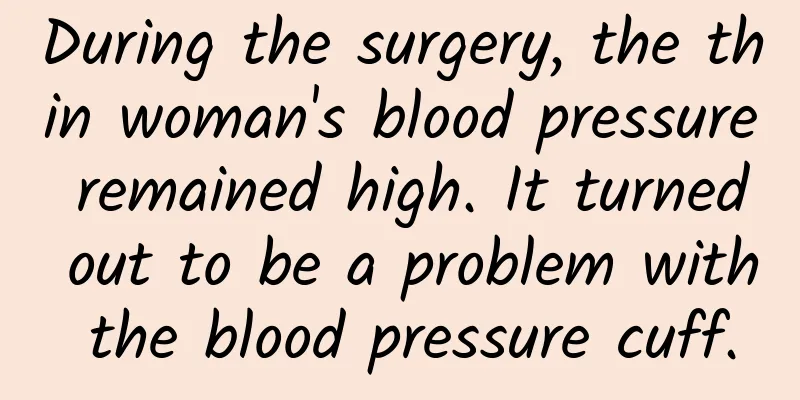During the surgery, the thin woman's blood pressure remained high. It turned out to be a problem with the blood pressure cuff.

|
At the Monday morning meeting, the director was furious again. The reason for his anger this time was mainly because he criticized the teaching problems of several of us senior doctors. Last week, an intern nearly caused a major problem with anesthesia by using the wrong blood pressure cuff. Here's what happened: The patient that day was a woman, probably in her 20s, very thin. She was nearly 1.7 meters tall and weighed only 40 kilograms. Her arms looked like those of a child. The intern saw that she was too thin, so he replaced the adult cuff. In his opinion, the cuff was too big for her. After changing to a pediatric cuff, it seemed to fit perfectly. We did not notice this detail when we were teaching. In this way, anesthesia began. However, even during the anesthesia induction stage, blood pressure remained high. At the time, we were puzzled: a girl in her 20s shouldn't have such high blood pressure. Besides, we had seen her various tests before the operation and asked her in detail during the visit, but we didn't find any signs that her blood pressure might be high. After all the investigations were fruitless, we thought she was resistant to anesthesia. Although we generally do not accept the term "resistant to anesthesia" from an anesthesia professional perspective, we do often encounter particularly severe cases. So we increased the dose of anesthesia. However, after a series of operations, we found an abnormality: as the depth of anesthesia increased, her pulse oxygen saturation waveform was getting lower and lower. Obviously, the blood pressure at this time was almost affecting the perfusion of her organs. Once the perfusion was affected, it was likely to cause organ function decline. At that time, it might not only affect the safety of anesthesia, but also bring serious conditions to the patient. So we checked the cause again. This time, when I reached under the surgical towel wrapped around her arm, I immediately found the problem: the cuff was wrong! It was like an experienced driver's instinctive reaction. When I touched it, the cuff that was supposed to be wide seemed to be gone. When I touched it carefully, there was only the wide cuff of the waistband. Did I make a mistake? No way! Absolutely not. Muttering to myself, I pulled the patient's arm out. When the arm was fully exposed, I was shocked: even though the arm was thin, it was not necessary to tie a cuff with only a belt width. This cuff should be for children! After just a few seconds, I opened the drawer of the anesthesia machine and found an adult cuff. After putting it on, I immediately pressed the blood pressure measurement button. When the blood pressure dropped from over 140 to just over 110, we finally knew what the problem was. Fortunately, the patient's vital signs were stable. Looking back, I am a little scared: if this was an elderly and frail patient, even if the error was only 30 mmHg, it would be enough to cause a big problem. 【Knowledge Point】For accurate blood pressure measurement, you must pay attention to the choice of cuff: choose a cuff with appropriate width, generally 2/3 of the length of the upper arm. If it is too wide, the measured value will be too low, and if it is too narrow, the measured value will be too high. In addition, the tightness of the cuff should be such that one finger can be inserted. If it is too loose, the measured blood pressure will be too high, and if it is too tight, the measured blood pressure will be too low. At this time, the intern was rubbing his hands in bewilderment. Although he was very scared, we didn't hold back and criticized him harshly. We needed to let him know that the object of our treatment was a human being, and we couldn't afford to be careless! |
>>: Are barramundi and saury the same fish? What is barramundi called?
Recommend
What should be paid attention to during breast abscess puncture
If women do not take good care of their breasts o...
A woman should have at least three men in her life
Among boyfriends, there should be a category of b...
Will the fetus stop growing after three months of pregnancy?
Pregnant women should be very afraid that the bab...
What are the dangers of overnight tea?
Another spring has come, and the new tea of the...
How many days after the menstrual period is the safe period?
Many female friends only know that having sex dur...
The placenta was born immediately and it was only level one
Pregnant women are pregnant for ten months. Durin...
How to deal with hunger during early pregnancy
Many female friends who are pregnant find that th...
There is a kind of morning sickness that makes you vomit to the point of doubting your life. It is called hyperemesis gravidarum. How should it be treated?
Author: Zou Liying, Chief Physician, Beijing Obst...
How to recover quickly after childbirth
Many women are afraid of having children. They th...
Can women with uterine fibroids eat dog meat?
The uterus is a particularly important reproducti...
How to treat teratoma? Complete list of treatment methods
I don’t know if you have heard of ovarian teratom...
How do you know if the vaginal stump is broken?
The vagina is a very important part for women. Wh...
Can I have menstruation without ovulation?
Generally speaking, we know that women have ovula...
Can acupuncture treat amenorrhea?
Menstruation is a normal physiological behavior o...
Breast tenderness and pain before menstruation
Many female friends will experience breast pain a...









